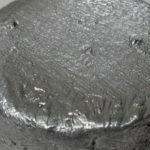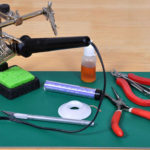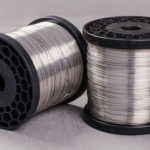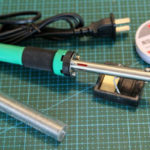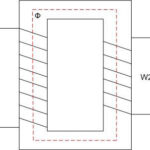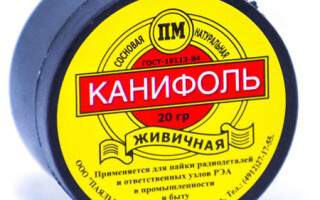The smell of heated rosin is known to many. Many people know that rosin is used to tinning and soldering of metals. What is the significance of this substance and what role does it play in the process - this remains to be seen.
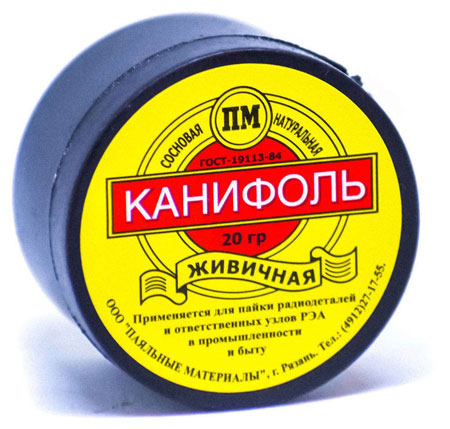
Content
Why do you need flux when soldering?
Quality soldering impossible without flux. Without its use, the solder will not "stick" to the metal being tinned. Flux tasks:
- dissolve dirt and oxides on the surface;
- prevent surface oxidation when heated with a soldering iron;
- reduce the surface tension of the molten solder drops.
Rosin performs these tasks well.
The main properties of rosin
Rosin is a fragile amorphous substance with a softening point of +50 to +150 degrees - depending on the composition and method of production. One of the versions of the origin of the name is from the ancient city of Colophon, where high quality pine resin was mined.Rosin has a color from pale yellow to dark brown (sometimes almost black) with a reddish tinge. It consists mainly of resins, fatty acids and some other substances. The composition is somewhat similar to the composition of amber.
Rosin does not dissolve in water, but it is highly soluble in ethyl alcohol, acetone and other organic solvents.
In addition to the qualities listed above, the substance also has other properties that are required for fluxes:
- chemical inertness to solders and soldered metals, as well as low corrosion activity;
- in molten form, rosin has good spreadability and wettability;
- its melting point is low, in some types of substance it does not exceed 70 degrees, which is enough for soldering even with Rose alloy;
- flux residues are easily removed with organic solvents.
The disadvantages include weak activity. Rosin is good for soldering metals that are easily amenable to this type of connection - copper, brass, bronze, etc. Soldering steel, not to mention aluminum, requires more active substances. As a rule, fluxes based on inorganic acids are used for these purposes.
Rosin is often used not only in solid form, but as part of liquid alcohol solutions or thick gels. The advantages of this implementation:
- lower consumption of rosin (a small concentration of the active substance is sufficient without reducing efficiency);
- reduced smoke generation for the same reason;
- the liquid composition is more convenient to apply (for example, with a brush);
- the amount of flux is easier to dose;
- flux in the form of a liquid penetrates even into small cracks.
In addition, such a composition is applied directly to the place of soldering, and the solid substance is first taken with a soldering iron tip. In the process of transferring to the tinned area, part of the flux evaporates or burns out before the process begins, which further increases consumption and increases the amount of smoke.
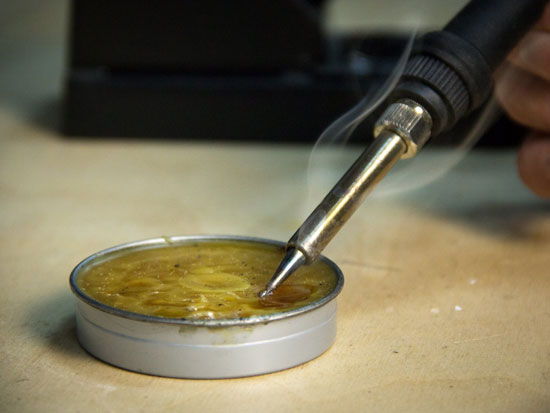
Also, other additives can be added to the alcohol solution to improve the effectiveness of the flux, for example, glycerin. You should know that this substance is hygroscopic, it easily absorbs water, becoming more electrically conductive, therefore, after soldering with such a flux, it is necessary to wash off the residues more thoroughly. Also, glycerin saturated with moisture can cause corrosion of the contact point over time.
How rosin is obtained
The main source of obtaining the substance is the natural resins of coniferous trees, which contain about one third of volatile substances (turpentine and others). After their evaporation, a solid residue is formed, which is pine rosin, which is also called harpius. Rosin is also sometimes found, made from spruce, fir or cedar resin. This type of rosin is called gum. The technology of its production can be reproduced even in artisanal conditions.
Resin collection is a laborious process, so it is more rational to extract rosin directly from wood pulp. In this case, sawdust of coniferous trees is treated with a solvent that draws out raw materials for further cleaning and evaporation. In this case, the final product has a darker color, but this does not affect the quality. Such rosin is called extraction. It is cheaper than gum, but additional substances from wood pulp and solvents get into its composition.This practically does not affect the quality of soldering, but for other areas of rosin use it may be important.

Rosin is also obtained by distilling tall oil, a by-product of pulp production. The result is tall rosin, it costs more than usual. In addition, this product and its vapors have a sharp, unpleasant odor. The advantages of such rosin include a lower softening point.
Other uses for rosin
This substance is used not only for soldering. Powdered rosin is used where it is necessary to increase friction, but abrasive action is undesirable. It is common to use such a powder mixed with other substances for rubbing the bows of stringed musical instruments, shoes of ballet dancers. Crushed rosin is used when practicing on various sports equipment (to reduce the likelihood of hands slipping), etc.
As a chemical substance, rosin is used in the production of varnishes, paints, plastics, rubber, etc. Water-repellent properties are used to impregnate paper and, in the past, wood structures.
Rosin has good dielectric properties, but mechanical qualities (fragility, exposure to external factors) do not allow it to be used in technology as an independent dielectric. It is part of various dielectric compounds.
Is rosin harmful
The advantage of rosin is its relative harmlessness. It does not contain toxic substances. However, when overheated with a soldering iron, non-toxic resins can decompose into more harmful components (some acids, pinoline, etc.).These substances are also of low toxicity, but prolonged inhalation can cause allergic reactions, irritation of mucous membranes, etc.
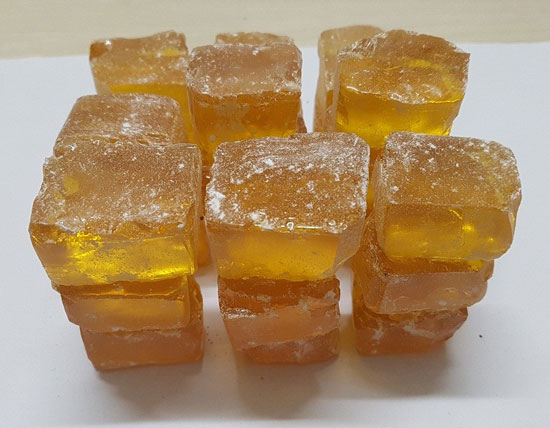
Synthetic types of rosin are less harmful in this regard, since they do not contain abietic acid, but such compounds are expensive. Long-term inhalation of rosin particles is also harmful - it can lead to asthma. Therefore, it is impossible to work with rosin in a production environment without an exhaust hood and personal respiratory protection equipment.
At home, it is difficult to imagine a master in a respirator, but the scale of smoke generation in such a situation is small. It is unlikely that infrequent periodic use of rosin at home can bring noticeable harm, however, work in a ventilated area is very desirable.
Important! All of the above applies to pure rosin. Other substances are added to industrial fluxes based on it (for example, the LTI series), making the composition more active, but also more harmful. Serious security measures must be taken when working with them.
Over the past decades, chemical production has taken a giant step forward. Nobody needs natural rubber anymore, many natural dyes have also been replaced by artificial ones. But rosin will be used for a long time in the same form as it was hundreds of years ago. An inexpensive and effective alternative is not yet in sight.
Similar articles:
